JSON Schema
 Priti Biyani
Priti Biyani
We all have been in a situation where we depend on other team/pair for APIs. And then when we try to consume those, the dialogues we get to here, “ Ohh, this was supposed to be Integer, but it’s a string now! “ or, “ This supposed to be an array and not an object!” and many such more …
This can happen because of expectation mismatch or poor sharing mechanism of contract. The new cropping API issues will surprise you more than yesterday and list will keep on growing! And one fine day, you will find yourself in a loop of checking more API issues and fixes. You will surely get dream of getting stuck in middle of horrible JSONs!
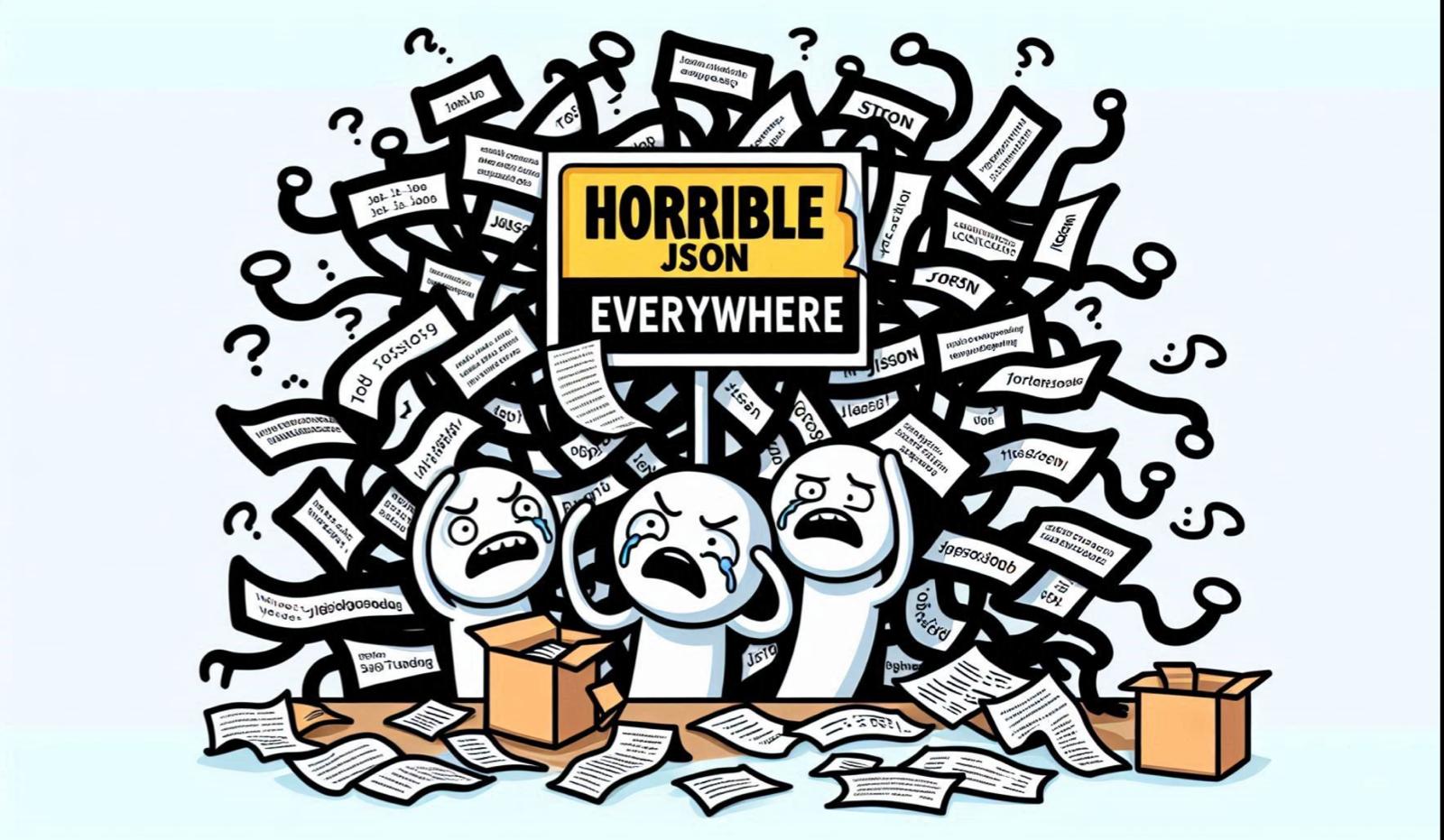
To tackle this situation, you need to start in very early phase. You can follow 2-step process to make your life easy when dealing with API:
Check for semantic and structure of API
Write a test to check structure and correctness of API.
The required fields are structured properly.
Correctness includes multiple factors such as checking for type of a field, mandatory fields, allowed values for particular fields, some additional constraints like nonzero, Integer etc., a specific requirement for a particular string (value should be correct email or value should follow particular date format).Journey based assertion
If API is satisfying above condition, then go ahead and write a test for a journey/scenario.
For eg., This one is a classic example. In a case of transferring amount from account A to B, the API test will transfer amount from account A to B and then will check if the amount is correct for both accounts.
For different languages, there are many libraries available to check rest API. For java, one can go with rest-assured, for Ruby, can use rest-client.
This blog post addresses how to check semantic and structure of the API. Let’s take one example:
This is what a contract looks like for one of the books in a list/collection.
As a consumer, you want to make sure following conditions are satisfied or not for book object:
Price should be always of float type and nonzero.
Author, title and price are mandatory fields.
If published date is present, it should follow standard date-time format.
There are ways of achieving above conditions, we can access a particular field in a JSON and perform the check for the type of a value or can check for the presence of a particular field. But as this list grows, you know how messy and ugly it becomes!
Similarly, let’s say you are an API provider and you want to let your consumers know about basic structure and rules of to be developed API, so that they can build on top of that.
If you had, above two problems then you must use JSON schema.
I’m a consumer of API and I don’t want to test API manually.
Use JSON Schema!I’m API provider, and along with the unit test, I want to check whether my API adheres to contract, what to do?
Use JSON Schema!We are working in a distributed team and development goes hand in hand, how to share contract?
Use JSON Schema!
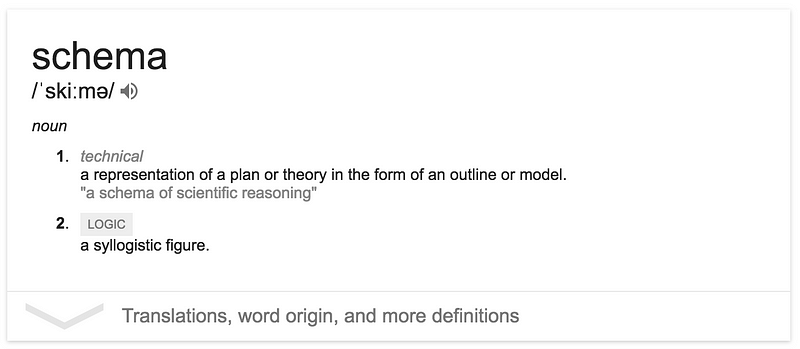
In simple terms, JSON schema is a contract for your JSON document. It defines rules for your contract and can validate JSON documents against the schema.
For the structure defined above, the schema would look like following:
Schema for book
Let’s go through this schema:
$schema keyword
The root level of schema contains this$schema, which signifies the location and version of the schema you will be using. This should be present at the top level of the schema, unlike we specify doctype tag in HTML document.type
It specifies the type of the root object. It should object always. Supported different types are an object, array, String, number, integer, boolean.properties, type
Then as we go next, we will find these keywords a lot.propertiesis used alternatively for JSON Object. The root levelpropertiestag contains the main chunk for a given JSON document.
You must have noticed it’s pretty easy to follow the schema and we can relate to actual JSON. Remember, the conditions we wanted to have as a consumer? Let’s see how these are being enforced by the schema. Given, as we are little familiar with JSON schema, it should be easy to follow those.
- Price should be always of float type and nonzero.
If we take a look at the following snippet, we see a type of price asnumber, which means that this field can only accept float values. Additionally, there are two fieldsminimumandexclusiveMinimum.minimumindicates that is can have minimum value as 0 (x >= 0 ). Another constraint,exclusiveMinimumis boolean. When it’s true, it indicates that range excludes minimum value and then our condition becomes (x > 0).
"price": {
"type": "number",
"minimum": 0,
"exclusiveMinimum": true
}
- Author, title and price are mandatory fields.
The following code snippet is self-explanatory. It interprets that only price, title and author are mandatory fields.
"required":
[
"author",
"title",
"price"
]
publishedOnif present, should follow date-time format.
The type is string. The format keyword allows validating certain kind of string. For example, date or email. As of now in version 4 of JSON schema, supported formats are email, date, ipV4 & ipV6 address, URI and hostname.
How to use this in your favorite language?
I have written code in Ruby and Java. These sample code validate the provided schema against the JSON document.
Sample demo in Ruby (using json-schema gem)
Sample demo in Java (using json-validator dependency)
If there are any errors in validating schema against JSON, the library gives an error in readable and user-friendly format. Remember, if there is an error at the top level, it will not go inside.
[
"The property '#/' did not contain a required property of 'author' in
schema file:///~/jsonSchema/schema/book_schema.json",
"The property '#/' did not contain a required property of 'price' in
schema file:///~/jsonSchema/schema/book_schema.json"
]
As per what I have observed, the validation is carried out in the following order: required properties and then it traverse inside the properties to check against specified rules. This is performed in sequence as the cursor digs deeper. You can play around more and check errors for Invalid JSON document.
Well, if Ruby or Java is not your favorite language, then you can check here for your preferred language.
You might be wondering, how to create this schema?
It will be error prone if we have to do that manually. Well, there are again libraries, which will create schema provided JSON document. jsonschema.net is an online tool which helps you to create basic schema provided JSON document. You can add additional constraints and rules as per the requirements.
How to check in editor
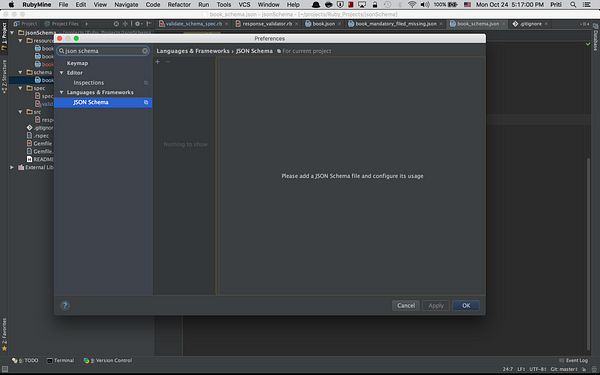
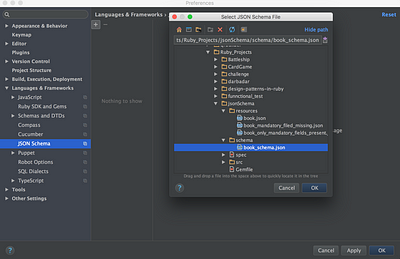
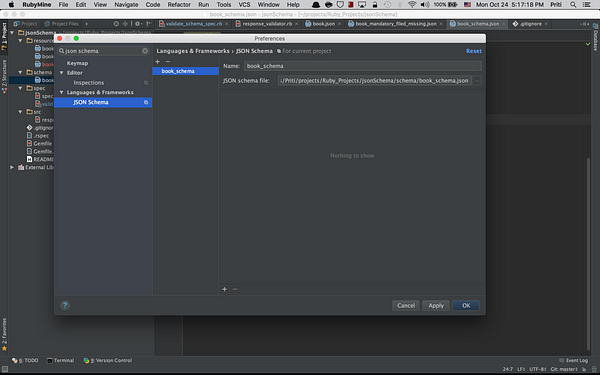
Using JsonSchema Plugin
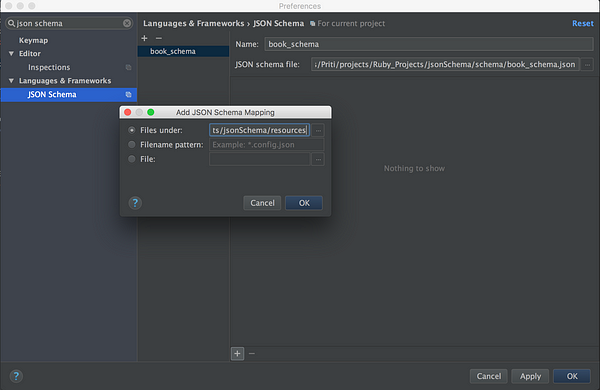
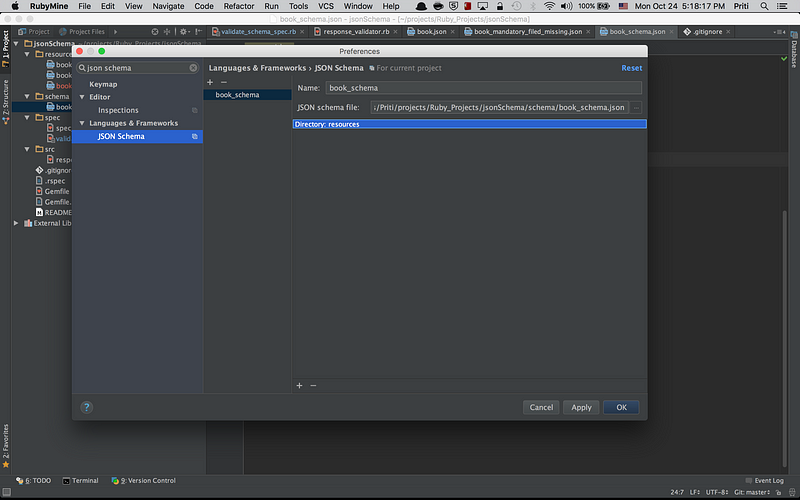
Specify JsonSchema files
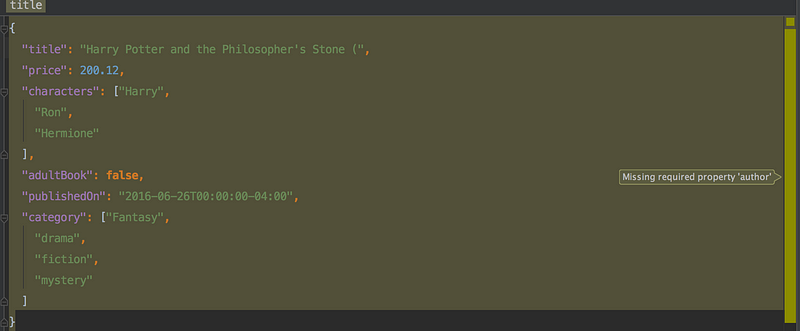
JsonSchemaValidation
If you are using any JetBrains IDE, there is a built-in plugin which can be used to validate JSON against a schema. You can follow the following screenshot to set up one for you.
Using built-in plugin for validation of schema and JSON document
To know in details, you can follow this link. The drawback of this built-in plugin is, if a schema is updated, it does not reflect on the fly for corresponding JSON document. So Use it with care!
Workflow
Given that you know how to write schema test, the important factor is, who should own these?
API provider?
API consumer?
In an ideal world, this is how it should happen:
Consumer and provider agree on a contract.
Provider should write schema test and these test should act as a one of the decision maker for API to be released.
Consumer will only get API which passes these schema test.
And the world of dealing with API is simpler? Isn’t it?
Summary
This blog post’s purpose was to make you introduce to JSON schema and how to use them. You can explore more by going through documentation and design schema as per your need.
The schema helps in a multiple way. It acts as a contract between two teams, serves as a specification, simple to read and easy to follow and you can use it for validation once your APIs are ready.
I greatly appreciate Swapnil Sankla for reviewing the post multiple times and for suggestions. I have learnt so much, thank you!
Originally published at https://pritibiyani.github.io.
Subscribe to my newsletter
Read articles from Priti Biyani directly inside your inbox. Subscribe to the newsletter, and don't miss out.
Written by

Priti Biyani
Priti Biyani
Ten-year ThoughtWorks veteran, based in Singapore. Skilled in full-stack development and infrastructure setup, now focusing on backend work. Passionate about TDD, clean code, refactoring, DDD and seamless deployment. I thrive on the entire software delivery spectrum, relishing the journey from conceptualisation to deployment Enjoys painting and dancing outside of work.